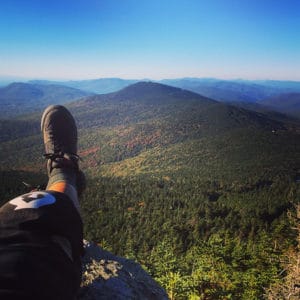By Merisa Sherman
I am sitting, cross-legged, on top of one of the oldest pieces of exposed rock in the world. The wind is swirling around me, almost like it’s about to lift me in a twirl off of the rock and into the sky. But the rock is grounding me, I can feel the cold seeping up through my pants and I know I am not going anywhere. My cold butt contrasts sharply with the warm sun on my face and my hair is blowing so much that I couldn’t see even if my eyes were open.

Taking a break to enjoy the view looking out over Coolidge Forest from Killington is relaxing.
My eyes are closed. I came here to this moment not to look out onto the beauty of the valley below me from this glorious mountain summit, but instead to feel the world around me. I let the wind envelop me like I am included in nature, not just an observer. I came here to feel, to listen and to start the month of November with a reminder of the glory. To remind myself how grateful I am to be here, in this place, in this moment.
I am so grateful for this place — the Calvin Coolidge State Forest in which Killington Peak is located — that I spent some time this week researching what is officially known as the Coolidge West Management Unit, which oversees our Coolidge West State Forest as well as Plymsbury and Tiny Pond Wildlife Management Areas. What started as only 3,362 acres in 1,933 has expanded over the past almost 90 years to almost 20,000 acres, including the 3324 acres known as Parker’s Gore, donated by Killington, Ltd. in 1998.
Perhaps it seems strange to be grateful for land and to the 10 men and women who actively work “to protect, sustain, and enhance Vermont’s natural resources, for the benefit of this and future generations.” Perhaps I watched “Gone with the Wind” too many times as a kid, listening to Scarlet O’Hara’s father tell her that “land is the only thing in the world worth workin’ for, worth fightin’ for, worth dyin’ for, because it’s the only thing that lasts.”
I can hear a girlfriend of mine’s voice in my ear, reminding me that this land was stolen from the native peoples who lived here centuries ago. As I sit on this ancient rock, I acknowledge that this was not originally our land but that of the Abenaki, of which the state of Vermont recognized several tribes in 2011. In many ways, I see the preservation of the forest as an attempt to return the land to the people, whatever color or creed they might be. This state forest belongs to all of us, and together we must protect this land.
My little cousin was 4 when I took her up the K1 Gondola for the first time. She was absolutely bursting at the seams. She wanted to show me everything that she knew, where this was, where that was. She wanted me to know that she knew what I knew about skiing and that she was part of everything. That seemed so important to her. She knew the way from Ramshead to the K1, and I was so proud of all her little controlled turns. Even though I hadn’t been the one to teach her those turns (I will be forever grateful, Tess), I felt like a proud ski mom.
She was so stoked on skiing and knowing the mountain that I had to share something with her. So I half cajoled, half tricked her little 4-year-old body into hiking up to the actual summit of Killington. When we got to the exposed rock beneath the fire tower, Megan just sat there. I showed her all the sights and the beauty of the Coolidge West Forest. But when I said it was time to leave, Megan didn’t even turn around to look at me; she just continued to sit there on the cold rock. Then she whispered reverently, “I wish that we could just stay here. It’s the most beautiful thing I’ve ever seen.” My heart burst. And so together we sat, in silence, until we were frozen popsicles.
In 1990, President Bush declared November as Native American Indian Heritage Month. For many of us, this month also marks a renewed commitment to gratefulness. The Nulhegan Band of the Coosuk Abenaki Nation in Barton teaches their children to respect and steward their ancestral homeland of N’dakinna, and we must do the same. Let us renew our commitment to preserving these lands, protecting and preserving our state forests, our national lands, our homes. We must pass on this sense of gratefulness that even a small child can appreciate. We must pass on love for the land, to preserve her uniqueness and beauty, for ourselves and all future generations. Because if we don’t, who will?




